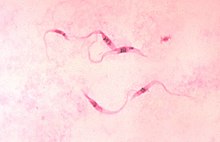Trypanosomatid
| Trypanosomes Temporal range: Albian to Recent 100–0 Ma | |
|---|---|
 | |
| Trypanosoma cruzi parasites | |
| Scientific classification | |
| Domain: | Eukaryota |
| Kingdom: | Excavata |
| Phylum: | Euglenozoa |
| Subphylum: | Mastigophora |
| Class: | Kinetoplastea |
| Order: | Trypanosomatida |
| Genera | |
- This article is about the order Trypanosomatida, see also the genus Trypanosoma.
Trypanosomatids are a group of kinetoplastid protozoa distinguished by having only a single flagellum. The name is derived from the Greek trypano (borer) and soma (body) because of the corkscrew-like motion of some trypanosomatid species. All members are exclusively parasitic, found primarily in insects. A few genera have life-cycles involving a secondary host, which may be a vertebrate, invertebrate or plant. These include several species that cause major diseases in humans.
The three major human diseases caused by trypanosomatids are; African trypanosomiasis (Sleeping Sickness, caused by Trypanosoma brucei), South American trypanosomiasis (Chagas Disease, caused by Trypanosoma cruzi), and leishmaniasis (a set of trypanosomal diseases caused by various species of Leishmania).
The family is known from fossils of the extinct genus Paleoleishmania preserved in dating to the Albian (100 mya) and Dominican amber from the Burdigalian (20-15 mya) of Hispaniola. The genus Trypanosoma is also represented in Dominican amber in the extinct species Trypanosoma antiquus.
Life cycle
Some trypanosomatids only occupy a single host, while many others : they live in more than one host species over their life cycle. This typically includes the intestine of a bloodsucking insect and the blood and/or tissues of a vertebrate. Rarer hosts include other bloodsucking invertebrates such as leeches and plants. Different species go through a range of different morphologies at different stages of the life cycle, most have at least two different morphologies. Typically the promastigote and epimastigote forms are found in insect hosts, trypomastigote forms in the mammalian bloodstream and amastigotes in intracellular environments.
Morphologies
Other features
Notable characteristics of trypanosomatids are the ability to perform trans-splicing of RNA and possession glycosomes where much of glycolysis is confined to. The acidocalcisome organelle was first identified in trypanosomes.
References
- Bütikofer P, Ruepp S, Boschung M, Roditi I (September 1997). "'GPEET' procyclin is the major surface protein of procyclic culture forms of Trypanosoma brucei brucei strain 427". Biochem. J. 326 (Pt 2): 415–23. PMC 1218686. PMID 9291113. http://www.biochemj.org/bj/326/0415/bj3260415.htm.
- Dean S, Marchetti R, Kirk K, Matthews KR (May 2009). "A surface transporter family conveys the trypanosome differentiation signal". Nature 459 (7244): 213–7. doi:10.1038/nature07997. PMC 2685892. PMID 19444208. http://www.pubmedcentral.nih.gov/articlerender.fcgi?tool=pmcentrez&artid=2685892.
- Engstler M, Boshart M (November 2004). "Cold shock and regulation of surface protein trafficking convey sensitization to inducers of stage differentiation in Trypanosoma brucei". Genes Dev. 18 (22): 2798–811. doi:10.1101/gad.323404. PMC 528899. PMID 15545633. http://www.genesdev.org/cgi/pmidlookup?view=long&pmid=15545633.
- Hofer A, Steverding D, Chabes A, Brun R, Thelander L (May 2001). "Trypanosoma brucei CTP synthetase: a target for the treatment of African sleeping sickness". Proc. Natl. Acad. Sci. U.S.A. 98 (11): 6412–6. doi:10.1073/pnas.111139498. PMC 33482. PMID 11353848. http://www.pnas.org/cgi/pmidlookup?view=long&pmid=11353848.
- Janovy, J; Roberts, L.S. (2005). Foundations of Parasitology (7th ed.). New York NY: McGraw Hill. pp. 61–69.
- Legros D, Ollivier G, Gastellu-Etchegorry M, et al. (July 2002). "Treatment of human African trypanosomiasis--present situation and needs for research and development". Lancet Infect Dis 2 (7): 437–40. doi:10.1016/S1473-3099(02)00321-3. PMID 12127356. http://linkinghub.elsevier.com/retrieve/pii/S1473309902003213.
- Matthews KR (January 2005). "The developmental cell biology of Trypanosoma brucei". J. Cell. Sci. 118 (Pt 2): 283–90. doi:10.1242/jcs.01649. PMC 2686837. PMID 15654017. http://jcs.biologists.org/cgi/pmidlookup?view=long&pmid=15654017.
- Matthews KR, Gull K (June 1994). "Evidence for an interplay between cell cycle progression and the initiation of differentiation between life cycle forms of African trypanosomes". J. Cell Biol. 125 (5): 1147–56. doi:10.1083/jcb.125.5.1147. PMC 2120053. PMID 8195296. http://www.jcb.org/cgi/pmidlookup?view=long&pmid=8195296.
- Morrison LJ, Marcello L, McCulloch R (December 2009). "Antigenic variation in the African trypanosome: molecular mechanisms and phenotypic complexity". Cell. Microbiol. 11 (12): 1724–34. doi:10.1111/j.1462-5822.2009.01383.x. PMID 19751359. http://onlinelibrary.wiley.com/resolve/openurl?genre=article&sid=nlm:pubmed&issn=1462-5814&date=2009&volume=11&issue=12&spage=1724.
- Seed JR, Wenck MA (June 2003). "Role of the long slender to short stumpy transition in the life cycle of the african trypanosomes". Kinetoplastid Biol Dis 2 (1): 3. doi:10.1186/1475-9292-2-3. PMC 165594. PMID 12844365. http://www.kinetoplastids.com/content/2/1/3.
- Shadan S (May 2009). "Microbiology: Signals for change". Nature 459 (7244): 175. doi:10.1038/459175a. PMID 19444199.
- Sherwin T, Gull K (June 1989). "The cell division cycle of Trypanosoma brucei brucei: timing of event markers and cytoskeletal modulations". Philos. Trans. R. Soc. Lond., B, Biol. Sci. 323 (1218): 573–88. doi:10.1098/rstb.1989.0037. PMID 2568647. http://rstb.royalsocietypublishing.org/cgi/pmidlookup?view=long&pmid=2568647.
- "African trypanosomiasis". World Health Organization. August 2006. http://www.who.int/mediacentre/factsheets/fs259/en/.
External links
- Trykipedia, Trypanosomatid specific ontologies
- Tree of Life: Trypanosomatida
Retrieved from : http://en.wikipedia.org/w/index.php?title=Trypanosomatid&oldid=454338344#Morphologies
No comments:
Post a Comment